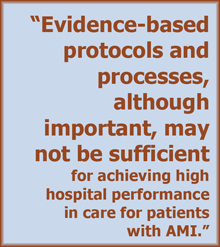Synopsis
When treating heart attack patients, simply following evidence-based practices or protocols, like administering a beta blocker, may not be enough. Regardless of whether hospitals in this quantitative study had comparatively high or low mortality rates related to heart attack care, they had no substantial differences in the use of such protocols. Instead, the researchers found that low-mortality hospitals shared other characteristics, including clear communication, strong coordination, and an organizational vision for providing high-quality care.
The Issue
 Mortality rates for patients with acute myocardial infarction (AMI)—commonly known as a heart attack—vary substantially across U.S. hospitals, even when researchers adjust for the severity of the condition or other factors like hospital volume, teaching status, and patients' socioeconomic status. This study sought to identify organizational factors, such as senior management involvement and communications, that are common among hospitals with low mortality rates. Researchers interviewed hospital staff at 11 hospitals that ranked in either the top or bottom 5 percent of AMI-related mortality rate performance.
Mortality rates for patients with acute myocardial infarction (AMI)—commonly known as a heart attack—vary substantially across U.S. hospitals, even when researchers adjust for the severity of the condition or other factors like hospital volume, teaching status, and patients' socioeconomic status. This study sought to identify organizational factors, such as senior management involvement and communications, that are common among hospitals with low mortality rates. Researchers interviewed hospital staff at 11 hospitals that ranked in either the top or bottom 5 percent of AMI-related mortality rate performance.
Key Findings
- There were no substantial differences in hospital protocols and processes for AMI care between high-performing and low-performing hospitals. Participants from all hospitals used a range of practices—such as rapid response teams or clinical guidelines—in varying combinations.
- Staff at high-performing hospitals shared the common organizational values of providing high-quality care, expressed as "a common vision and purpose," the "glue" of the organization, and "the driving force behind everything."
- Senior management at high-performing hospitals demonstrated firm commitment to high-quality care by providing adequate resources and using quality data in strategic planning efforts. At low-performing hospitals, involvement of senior management was sporadic, in part because of frequent turnover. In addition, interviewees said insufficient resources were allocated to quality, data were used intermittently or ineffectively, and management did not create an environment in which ownership of performance was encouraged.
- Staff at high-performing hospitals reported the presence of physician leaders, empowered nursing staff, and involved pharmacists. In low-performing hospitals, physicians' engagement in championing AMI quality improvement was weak or nonexistent, nurses were not consistently treated as valued members of the team, and pharmacists' roles were limited.
- Strong communication and coordination were apparent at high-performers, with staff recognizing their interdependent roles in patient care. In contrast, low-performing hospitals reported that the flow of information was constrained by poor structural supports, such as irregular committee meetings or inefficient information technology.
- Staff at high-performing hospitals used root-cause analysis to learn from experiences and improve care. At low-performers, problem-solving was less constructive and finger-pointing was more common.
Addressing the Problem
In the absence of a supportive organizational culture, specific clinical interventions may not be sufficient for improving care and reducing mortality rates for patients with AMI, the authors conclude. This study identified the following factors that can help hospitals improve: setting clear goals to be the best, coupled with strong engagement from senior management and staff members of diverse disciplines; solid communication and coordination; and addressing the root causes of problems.
About the Study
The researchers identified hospitals that ranked in either the top or bottom 5 percent of performance on 30-day risk-standardized mortality rates for patients hospitalized with AMI during two periods, 2005 to 2006 and 2006 to 2007. From December 2008 to December 2009, they interviewed 158 hospital staff members who were most involved with AMI care. Eleven hospitals participated in the study.
Key Findings
Reducing the risk of death for heart attack patients requires not only evidence-based clinical practices, but an organizational culture that supports high-quality care, teamwork, and coordination.